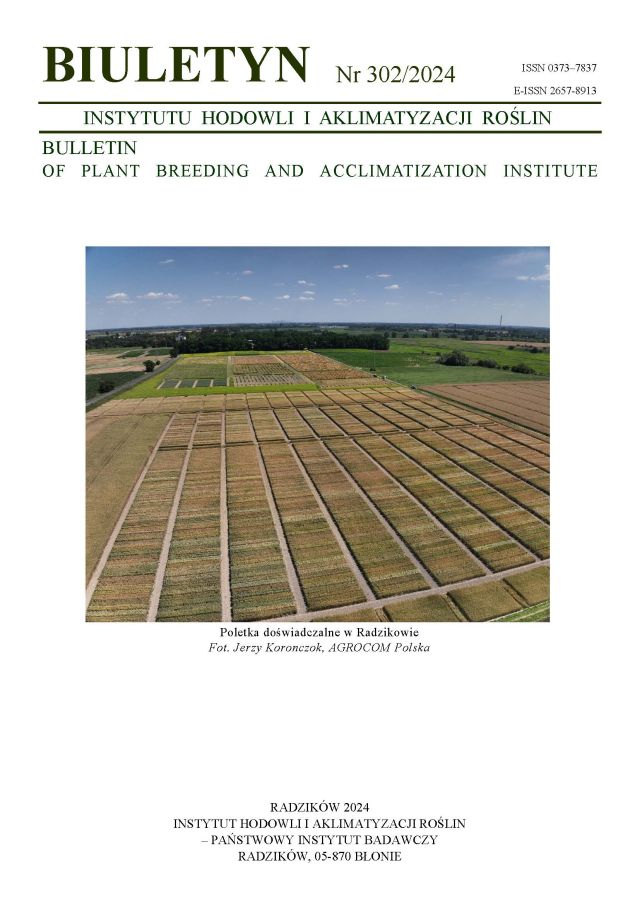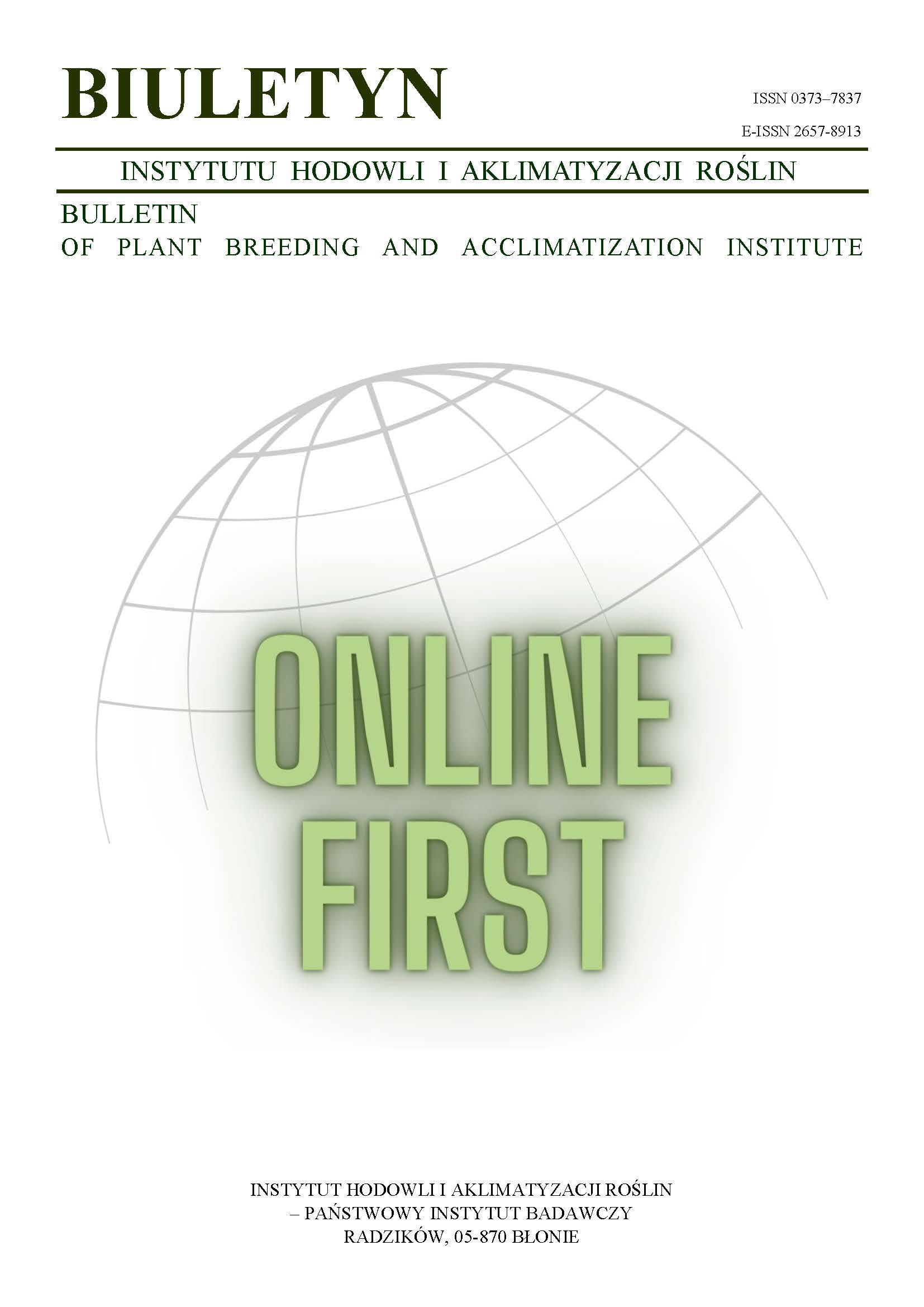The usefulness of gene mutation for the improvement of seed yield productivity in alfalfa (Medicago sativa L.)
Abstract
The effects of introgression of the recessive genes lp (long raceme) and tf (top inflorescence) into alfalfa cv. Radius on seed productivity were evaluated in field experiments. Introgression of the gene lp resulted in the change of a type of inflorescence, significantly increasing the numbers of pods and seeds per raceme. The seed yield of a new synthetic cv. Ulstar (lp type) was higher by 15–20% than those of standard cultivars producing typical, short racemes. Two mutant tf-type plants, selected from cv. Ulstar, were intercrossed, and the F1 and F2 progenies containing the recessive gene tf were derived. In the F2 progenies both the number of racemes per stem and the seed yield were larger than those in cv. Ulstar.
Keywords:
alfalfa, long raceme, mutation, seed yield, top floweringReferences
Allard R. W. 1968. Krzyżowanie wsteczne w: Podstawy hodowli. PWRiL, Warszawa: 160 — 175.
Google Scholar
Bocsa I., Pummer L. 1994. Eleven year selection for seed productivity improvement of lucerne. Rep. of the XXXIVth Alfalfa Improvement Conference. Guelph: 95.
Google Scholar
Bocsa I., Pummer L. 1997. Seed production and breeding for stability of fertility. Proc. of the XIIth Eucarpia Meeting of the Group Medicago. Brno: 87 — 93.
Google Scholar
Bodzon Z. 1998. Inheritance of spontaneous long peduncle mutation in alfalfa (Medicago sativa L.) Plant Breed. and Seed Sci. 42/1: 3 – 9.
Google Scholar
Bodzon Z. 2004. Correlations and heritability of the characters determining the seed yield of the long raceme alfalfa (Medicago sativa L.). J. Appl. Gen. Vol. 45 (1): 49 — 59.
Google Scholar
Broniarz J. 1988. Metodyka badania wartości gospodarczej odmian (WGO) roślin uprawnych. Rośliny rolnicze. Motylkowate drobnonasienne. Wyd. I, COBORU, Słupia Wielka.
Google Scholar
Broniarz J. 1997. Syntezy wyników doświadczeń odmianowych. Motylkowate drobnonasienne. COBORU, Słupia Wielka, z. 1114: 27 — 40.
Google Scholar
Djukič D., Kraljevič-Balalič M. 1993. Variability of seed yield components of random pollinated alfalfa. Proc. of the Xth Eucarpia Conference, Medicago Group. Lodi: 422 — 428.
Google Scholar
Hill R. R. Jr., Shenk J. S., Barnes R. F. 1988. Breeding for yield and quality in Monog. 29: Alfalfa and alfalfa improvement (Hanson A. A., Barnes D. K., Hill R. R. Jr. — eds.), Am. Soc. Agron.: 809 — 825.
Google Scholar
Huyghe C., Bolaños-Aguilar E. D., Ecalle C., Julier B. 1998. Distribution of the seed in an alfalfa canopy. Rep. of the XXXVI th Alfalfa Improvement Conference. Bozeman: 57.
Google Scholar
Huyghe C., Bolaños-Aguilar E. D., Ecalle C., Hacquet J., Julier B. 1999. The seed weight per inflorescence as a selection criterion for seed yield in alfalfa. Proc. of the XIIIth Eucarpia Medicago Group Meeting: 65 — 70.
Google Scholar
Jaranowski J., Dyba S. 1983. Genetyczno-hodowlane możliwości poprawiania plonowania nasion lucerny mieszańcowej. Zesz. Probl. Post. Nauk Rol. 253: 25 — 33.
Google Scholar
Lorenzetti F. 1993. Achieving potential herbage seed yield in species of temperate regions. Proc. of XVIIth Grassland Congress: 1621 — 1628.
Google Scholar
Rumbaugh M. D., Caddel J. L., Rowe D. E. 1988. Breeding and quantitative genetics in Monog. 29 Alfalfa and alfalfa improvement (Hanson A. A., Barnes D. K., Hill R. R. Jr. (eds.), Am. Soc. Agron.: 777 — 808.
Google Scholar
Simon U. 1997. Environmental effects on seed production in lucerne. Proc. of the XIIth Eucarpia Meeting of the Group Medicago, July 2–5 1996, Brno, Czech Republic: 123 — 134.
Google Scholar
Skalska M. 1993. Plonowanie odmian lucerny siewnej i mieszańcowej w uprawie na nasiona. Biul. IHAR 186: 103 — 111.
Google Scholar
Staszewski Z. 1986. Long peduncle lp mutation — a promise for seed yield improvement of alfalfa. Rep. of the XXXth North American Alfalfa Improvement Conference. University of Minnesota: 75
Google Scholar
Staszewski Z. Bodzon Z. 2002. Przydatność genu lp do zwiększenia plonowania nasiennego lucerny siewnej (Medicago sativa L.). Biul. IHAR 221: 167 — 173.
Google Scholar
Staszewski Z., Bodzon Z., Staszewski L. 2001. Influence of some recessive genes on plant and inflorescence characteristics in alfalfa. Plant Breed. Seed Sci. 45/1: 43 – 53.
Google Scholar
Staszewski Z., Jagodziński J., Jakubowska B., Osiński R. 1990. Lucerne mutations useable for increasing seed yields. Proc. of Meeting Fodder Crops Section of Eucarpia. Wageningen: 18 — 19.
Google Scholar
Staszewski Z., Staszewski L., Osiński R. 1992. Top flowering — spontaneous mutation of Medicago sativa L. The future of lucerne. Proc. of the Xth Eucarpia Meeting of the Group Medicago. Lodi.: 392 — 395.
Google Scholar
Užik M. 1997. Perspective of alfalfa selection for raceme length and seed yield. Proc. of the XIIth Eucarpia Meeting of the Group Medicago, Brno: 71 — 73.
Google Scholar
Authors
Zbigniew Bodzonz.bodzon@ihar.edu.pl
Instytut Hodowli i Aklimatyzacji Roślin w Radzikowie Poland
Statistics
Abstract views: 123PDF downloads: 88
License
Copyright (c) 2007 Zbigniew Bodzon

This work is licensed under a Creative Commons Attribution-ShareAlike 4.0 International License.
Upon submitting the article, the Authors grant the Publisher a non-exclusive and free license to use the article for an indefinite period of time throughout the world in the following fields of use:
- Production and reproduction of copies of the article using a specific technique, including printing and digital technology.
- Placing on the market, lending or renting the original or copies of the article.
- Public performance, exhibition, display, reproduction, broadcasting and re-broadcasting, as well as making the article publicly available in such a way that everyone can access it at a place and time of their choice.
- Including the article in a collective work.
- Uploading an article in electronic form to electronic platforms or otherwise introducing an article in electronic form to the Internet or other network.
- Dissemination of the article in electronic form on the Internet or other network, in collective work as well as independently.
- Making the article available in an electronic version in such a way that everyone can access it at a place and time of their choice, in particular via the Internet.
Authors by sending a request for publication:
- They consent to the publication of the article in the journal,
- They agree to give the publication a DOI (Digital Object Identifier),
- They undertake to comply with the publishing house's code of ethics in accordance with the guidelines of the Committee on Publication Ethics (COPE), (http://ihar.edu.pl/biblioteka_i_wydawnictwa.php),
- They consent to the articles being made available in electronic form under the CC BY-SA 4.0 license, in open access,
- They agree to send article metadata to commercial and non-commercial journal indexing databases.
Most read articles by the same author(s)
- Zbigniew Bodzon, Inheritance of spontaneous panicle inflorescence mutation in alfalfa (Medicago x varia T. Martyn) , Bulletin of Plant Breeding and Acclimatization Institute: No. 267 (2013): Regular issue
- Zbigniew Bodzon, Inheritance of determinate growth habit in alfalfa (Medicago sativa L.) , Bulletin of Plant Breeding and Acclimatization Institute: No. 281 (2017): Regular issue
- Zbigniew Bodzon, Correlations of the characters determining the seed yield of birdsfoot trefoil (Lotus corniculatus L.) , Bulletin of Plant Breeding and Acclimatization Institute: No. 274 (2014): Regular issue
- Anna Szydłowska, Elżbieta Małuszyńska, Zbigniew Bodzon, The germination capacity of birdsfoot trefoil seeds (Lotus corniculatus L.) depending on disinfection formulation and maturity of seeds , Bulletin of Plant Breeding and Acclimatization Institute: No. 274 (2014): Regular issue














